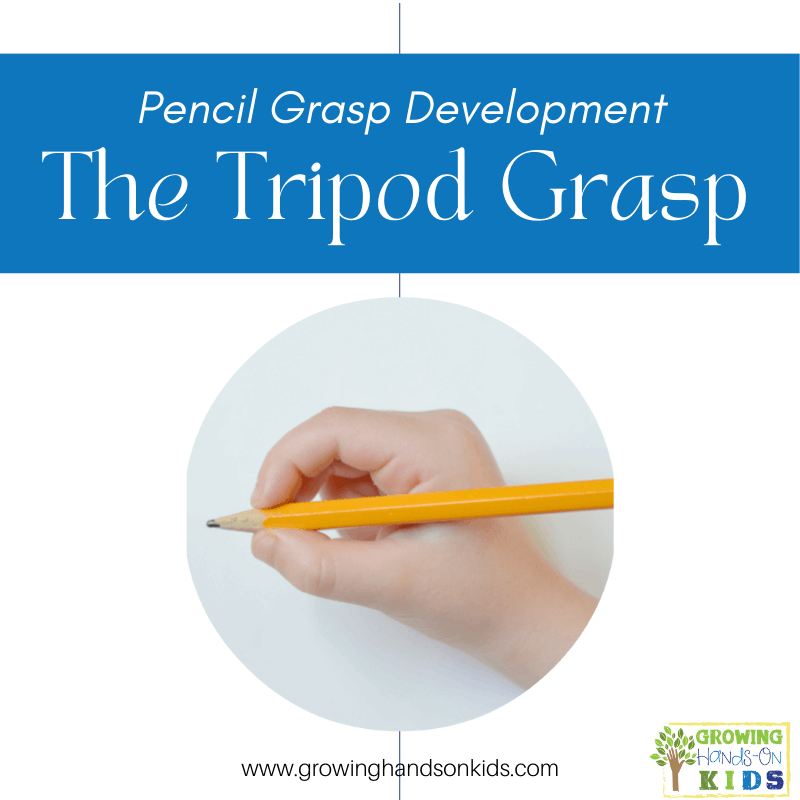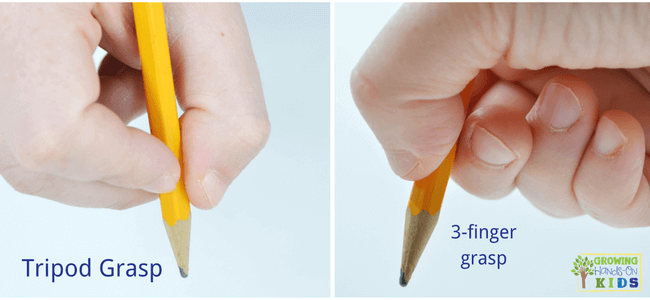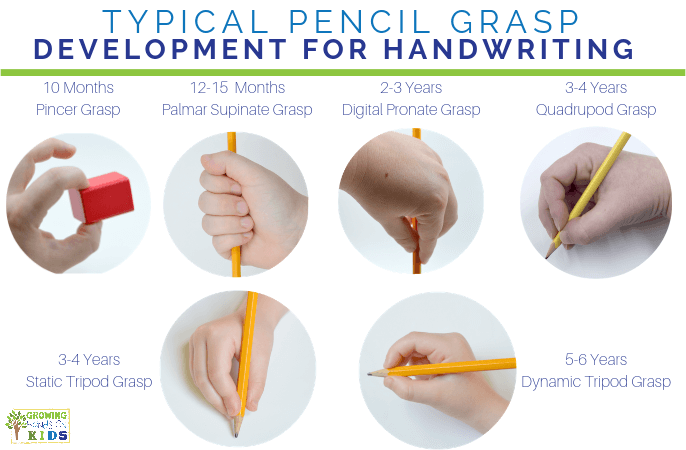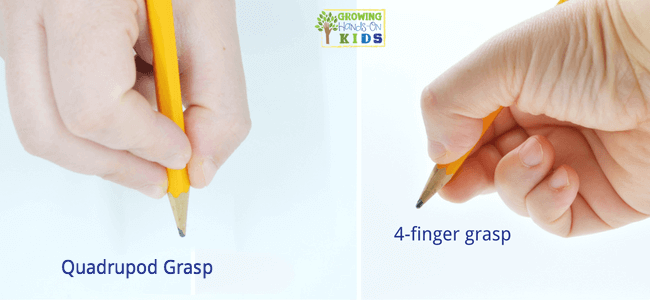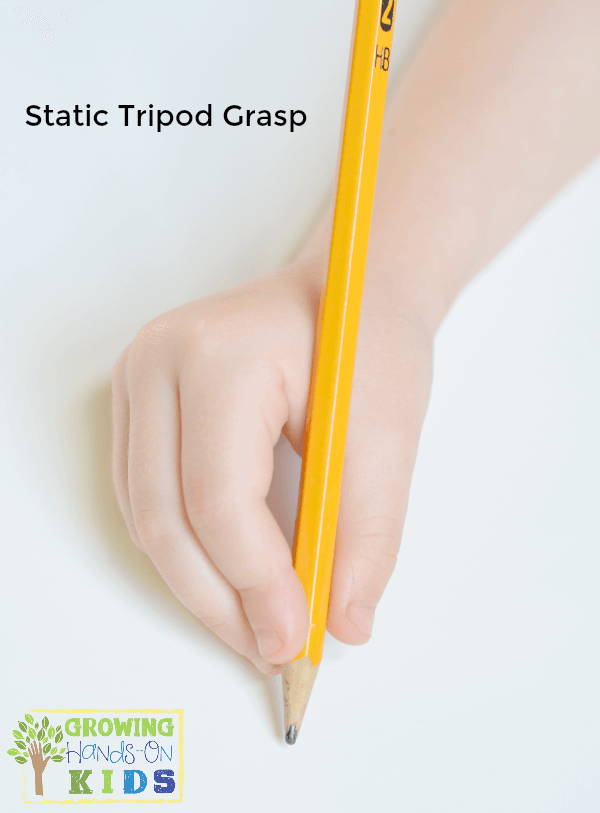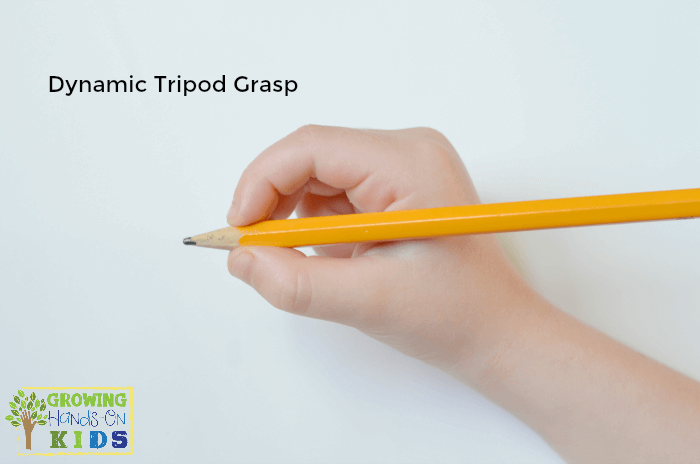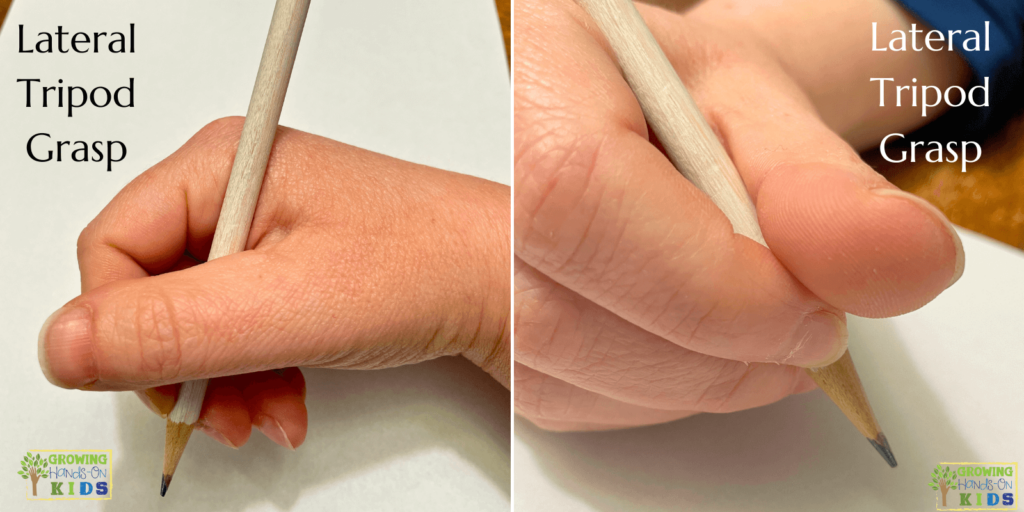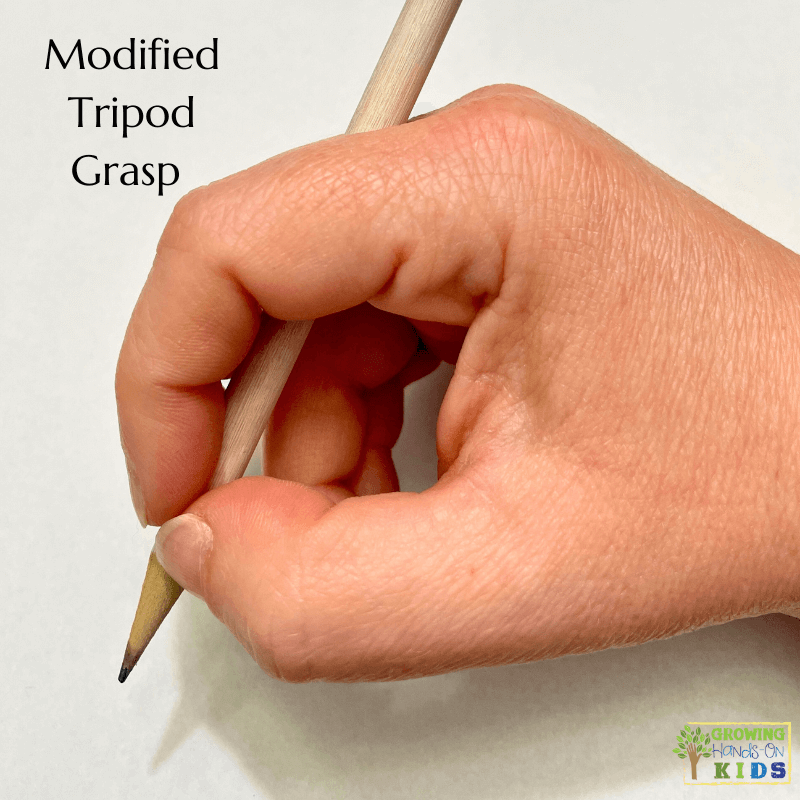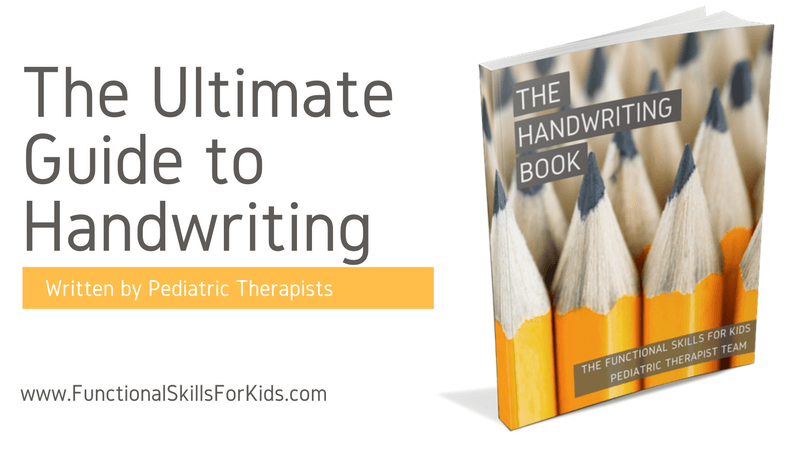Pencil Grasp Development: The Tripod Grasp
Affiliate and Referral links are used below to promote products I love and recommend. I receive a commission on any purchases made through these links. Please see my disclosure policy for more details. As an Amazon Associate, I earn from qualifying purchases.
If you've landed on this post, you're probably researching pencil grasps and wondering why you keep seeing words like tripod grasp or other types of grasps thrown around. What is the big deal with pencil grasps and handwriting anyways?
Today we're going to take an in-depth look at pencil grasp development, particularly the tripod grasp. Let's break this down into easy-to-understand terms with pictures!
The Tripod Grasp Table of Contents
- What is a Tripod Grasp?
- Static Quadrupod Grasp
- Static Tripod Grasp
- Dynamic Quadrupod Grasp and Dynamic Tripod Grasp
- Lateral Tripod Grasp
- Modified Tripod Grasp: An Adaptive Grasp
- What is an immature tripod grasp?
- Is the Tripod Grasp the Best Pencil Grasp?
- Mature Left-Handed Grasp
- Activities to Promote Functional Pencil Grasp
What is a Tripod Grasp?
The tripod grasp is a three-fingered grasp that typically develops between the ages of 4 and 6 to sometimes 7 years old.
For this grasp, a child holds the pencil between the thumb and index finger with the pencil resting on the middle finger. The 4th and 5th fingers (ring finger and pinkie finger) are tucked inside the palm of the hand. The space between the thumb and index finger is referred to as the web space. In a tripod grasp, this web space is open and shows almost a complete circle around the pencil as shown below.
The tripod grasp is considered a mature grasp for handwriting. There are many other types of pencil grasp that come before the tripod grasp and you can read about those in my pencil grasp development for handwriting post.
Let's look at how the tripod grasp develops specifically.
Static Quadrupod Grasp
When a child starts to hold a writing utensil with their fingers towards the writing end of it, you may notice them using a quadrupod grasp, or a four-fingered grasp. This includes the thumb, index, and middle finger grasping the pencil, while the pencil itself is resting on the 4th or ringer finger. The 4th and 5th fingers are tucked into the palm of the hand.
The movement from this grasp comes from the wrist, elbow, and shoulder, while the fingers remain static on the pencil.
The static quadrupod grasp will emerge around 3 to 4 years old and may turn into a static tripod grasp.
Static Tripod Grasp
A static tripod grasp refers to where the movement of the grasp comes from. In a static tripod grasp, the three fingers are holding the pencil, but the movement of the pencil comes from the wrist, elbow, and shoulder, not the fingers. The fingers remain static.
A static tripod grasp is typically seen between the ages of 3 and 4 years old and is considered developmentally appropriate for this age.
Dynamic Quadrupod Grasp and Dynamic Tripod Grasp
As a child progresses in their pencil grasp development, we look for static movements to become dynamic. In other words, we want to start seeing the fingers moving and being the ones to move the pencil across the page, not the wrist, elbow, or shoulder.
A dynamic quadrupod or dynamic tripod grasp can develop anywhere from 5 to 6 years old, sometimes even 7 years old.
Lateral Tripod Grasp
As we will talk about, there are a few other types of functional tripod grasp patterns, and that includes the lateral tripod grasp.
This grasp is defined as a three-fingered grasp, with the thumb, index finger, and middle finger. The difference here is the placement of the thumb. Instead of having a defined open-web space where the pencil sits between the thumb and index finger, the pencil is held with the lateral, or inside of the thumb. The webspace is not as open, but the movement of the pencil should still come from the fingers and not the wrist, elbow, or shoulder.
You can also have a lateral quadrupod grasp, which would be a four-fingered grasp with the pencil being held by the lateral side of the thumb. This is what I tend to personally use when I hold a pencil for writing.
Modified Tripod Grasp: An Adaptive Grasp
Another functional grasp is the modified tripod grasp. You may also see this referred to as an adaptive grasp as it does provide more stability for holding the pencil for some children who need that.
This grasp can be described as a three-fingered grasp, however, the pencil is placed between the index finger and 3rd finger, instead of the open web space between the thumb and index finger.
Again, we are looking for dynamic movement of the fingers and not static movement.
I once had a student who had broken his writing arm. The cast prevented him from using his thumb for grasping the pencil appropriately because the thumb was included in the cast. So he adapted his grasp to a modified tripod grasp and had great success with it. Once the cast came off, he kept using the modified tripod grasp and it had no effect on his writing speed or legibility. In fact, he said it was uncomfortable to write with a “regular” tripod grasp. In this case, both the Occupational Therapist, who was my supervisor, and I agreed that trying to change his grasp back to a “regular” tripod grasp from the modified grasp was not appropriate.
What is an immature tripod grasp?
An immature tripod grasp specifically would mean that a child past the age of 6 or 7 is using a static grasp, instead of moving to a dynamic grasp.
Remember static means the movement is coming from the wrist, elbow, and shoulder and dynamic is when the movement comes from the fingers.
An immature grasp could affect the child's handwriting ability if they are not able to control and manipulate the pencil in an effective way for letter formation during writing. This could also affect their handwriting speed and legibility.
It could be an immature tripod grasp or even a lateral or modified quadrupod grasp. What makes the grasp immature is the fact that the arm is moving the pencil across the page, not the fingers.
Another immature grasp would include the 5-finger grasp, meaning all 5 fingers are touching the pencil to hold it. It is important to remember that younger children, under age 4-5 may use a 5-fingered grasp as they are learning to hold a pencil. But we also want to see them move out of using that 5-fingered grasp to a 4 or 3-fingered grasp with dynamic movement by the time Kindergarten has finished.
Is the Tripod Grasp the Best Pencil Grasp?
The short answer is the tripod grasp is not the only functional grasp for our children. You may not use a tripod grasp yourself and have wondered why so much focus has been placed on having a tripod grasp.
Personally, I go between a dynamic quadrupod grasp and lateral quadrupod grasp.
It is true that a dynamic tripod grasp has been held as the “gold standard” of pencil grasp development. And it can also be true that this grasp allows for the most dynamic movement with handwriting with fewer fingers being on the pencil. However, we also want to look at function.
The Australian Occupational Therapy Journal published an article in 2012 that found the following:
“The dynamic tripod pencil grasp did not offer any advantage over the lateral tripod or the dynamic or lateral quadrupod pencil grasp in terms of quality of handwriting after a 10-minute copy task. These four pencil grasp patterns performed equivalently. Our findings question the practice of having students adopt the dynamic tripod pencil grasp.” (Source)
Another study in the American Journal of Occupational Therapy found this:
“Interventions for handwriting difficulties should focus more on speed and letter formation than on grasp pattern.” (Source)
Does this mean we should not even try to encourage a tripod grasp? I don't think that is the case. When a child is learning to write and hold a pencil, showing them how to hold a pencil with a tripod grasp can still be very beneficial.
However, I think it also means we don't need to beat ourselves up if our child is just not using a tripod grasp, but IS using one of the other functional grasps we talked about above.
When looking at how a child holds a pencil for writing, we need to look beyond just the looks of how they are holding it. More importantly, we need to look at their writing speed and legibility.
When would changing a child's pencil grasp be appropriate?
- When handwriting speed is negatively affected
- When legibility is affected (letter formation, spacing, sizing, etc)
- When a child complains of pain or fatigue when writing
If your child is having legibility and handwriting speed challenges and complains of pain or fatigue during writing tasks, it's important to talk to their teacher and/or ask for an Occupational Therapy evaluation from their school or from their pediatrician. Occupational Therapists can evaluate what is at the root of these challenges and address any fine motor, gross motor, or visual-motor challenges that may be affecting their handwriting.
Mature Left-Handed Grasp
Most of the information you find is for right-handed children, so I wanted to be sure to include information for left-handedness.
Children who hold the pencil with the left hand develop their grasp patterns in the same way as a right-handed individual. We are still looking for age-appropriate development through the static quadrupod and tripod grasp to dynamic movements.
Also, remember that handedness is not really decided until ages 5-6, so seeing a child switch hands between the right and the left in preschool is still developmentally appropriate.
An important thing to watch for with left-handed writers is their paper placement and to avoid the “wrist hook” that you might see.
Left-handed writers will also need to hold the pencil higher up on the pencil, an inch to an inch and a half from the tip of the pencil. This will help to avoid the wrist hook, which many left-handed writers use so they can see what they are writing.
You will want to make sure that the writing paper is set at an angle with the left side of the paper pointed up. Right-handed writers tend to tilt the paper with the right corner pointed up.
You can find more tips for teaching left-handed writers in this post by an Occupational Therapist, Teaching Left-Handed Kids to Write: Grasp, Stages, and Positioning.
Activities to Promote Functional Pencil Grasp
I am specifically calling these activities for functional grasp instead of tripod grasp, since as we've learned, a true tripod grasp may not be the end goal for all our children. However, we should be focused on encouraging a functional grasp and this can be done through gross motor skills, fine motor skills, and hand and finger strengthening activities.
1 || Bilateral Coordination
Bilateral coordination is using both sides of the body together in order to complete a task. In the case of handwriting, one side of the body is doing the “work”, while the opposite side is stabilizing, or holding the paper or writing surface. Children who struggle with bilateral coordination could also struggle with handwriting and other gross motor or fine motor skills.
7 ways to improve bilateral coordination
2 || Crossing Midline
Imagine there is a line going down the middle of your body from your head through the torso, essentially splitting your body into two sides. Handwriting requires one side of your body to cross over this midline and be able to write starting from left to right. It not only required physically crossing this midline with the writing hand but also visually crossing the midline with the eyes.
10 Activities for Crossing Midline
3 || Core Strength and Shoulder Stability
Part of holding a pencil efficiently is having good posture while writing. This means having the feet flat on the floor, hips at 90 degrees, and sitting upright, not slouching. This also puts the shoulder into a good position without putting weight on the shoulder through the elbow, which would happen when a child is in a slouched position and using their arm to hold themselves up.
In development, large muscle groups develop first, followed by smaller muscle groups. So when we notice poor posture during handwriting, addressing any core muscle strength concerns is important.
Some great ways to include core strength include having children lay on their stomachs or kneel and doing an activity on a vertical surface. And other general exercises like sit-ups and yoga can be greatly beneficial.
4 || Hand Strength and In-Hand Manipulation
In-hand manipulation means being able to move an object in the hands efficiently without using the other hand for support or using a flat surface to stabilize. So for example, being able to grab a group of coins and then move one coin at a time to the tip of the fingers to drop it into a container, while still holding onto the other coins in the palm would be good in-hand manipulation.
This is needed for grabbing a pencil and moving it efficiently into a writing position.
In-hand manipulation activities for kids
Hand strength can also help with avoiding fatigue when writing. Many fine motor activities will help promote good hand strength and in-hand manipulation skills.
5 || Finger Strength and Pincer Grasp
Before we can expect children to hold a pencil, we want to make sure they have a good pincer grasp and finger dexterity, and strength.
15 Activities to Promote Pincer Grasp
6 || Visual-Motor Skills
Finally, visual-motor skills like eye-hand coordination are important for handwriting. Being able to coordinate vision and movement together is an important part of handwriting that may get overlooked.
If your child is struggling with any fine motor, gross motor, and/or handwriting skills, it's important to have their vision checked first to make sure there is nothing physically going on with the eyes. Once that has been either ruled out or addressed, then addressing any visual motor integration challenges would be an important next step.
You can read more about visual motor skills below:
I need to stop here before this post becomes a small book. 😉 But speaking of books, I helped to co-author The Handwriting Book with 10 other pediatric physical therapists and occupational therapists. We address a lot of handwriting challenges and give lots of tips for many of the things I talked about in this post.
You can check out The Handwriting Book here.
References:
Benbow, M. (2006). Principles and Practices of Teaching Handwriting. In Hand Function in the Child Foundations for Remediation (pp. 319-342). Mosby Elsevier.
Elliott, J. M & Connolly, K. J. (1984). A classification of manipulative hand movements. Developmental Medicine and Child Neurology, 26 (3), 283-296.
Pollock, N., Lockhart, J., Blowes, B., Semple, K., Webster, M., & Farhat, L. et al. (2009). Handwriting Assessment Protocol (2nd ed.). McMaster University.
Schwellnus, H., Carnahan, H., Kushki, A., Polatajko, H., Missiuna, C., & Chau, T. (2012). Effect of pencil grasp on the speed and legibility of handwriting after a 10-minute copy task in Grade 4 children. Australian Occupational Therapy Journal, 59(3), 180-187. (Source)
Schwellnus H, Carnahan H, Kushki A, Polatajko H, Missiuna C, Chau T. Writing forces associated with four pencil grasp patterns in grade 4 children. Am J Occup Ther. 2013 Mar-Apr;67(2):218-27. doi: 10.5014/ajot.2013.005538. PMID: 23433277; PMCID: PMC3722657.

Heather Greutman, COTA
Heather Greutman is a Certified Occupational Therapy Assistant with experience in school-based OT services for preschool through high school. She uses her background to share child development tips, tools, and strategies for parents, educators, and therapists. She is the author of many ebooks including The Basics of Fine Motor Skills, and Basics of Pre-Writing Skills, and co-author of Sensory Processing Explained: A Handbook for Parents and Educators.

